|
| |
Archives
scanner travels
I got half way through my links and them work buried me. Hopefully I can get them up tonight. The good news is that my scanner is a little bit closer. It arrived in Hodgkins, Illinois, (right outside of Chicago) at 6:48am yesterday and left at 10:14pm. [cue Willie Nelson singing On the road again....] But who's paying attention?
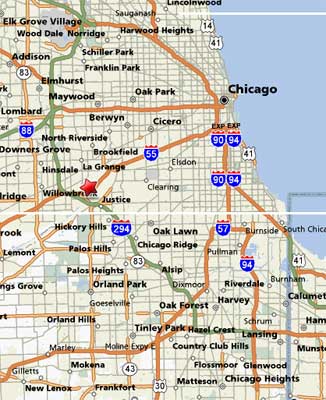
|
Wednesday November 1 2006
|
more after a required sleep cycle sidetracked by work
painting
This is an 8.6 gigapixel image that you can really zoom in on!
Vita di Cristo
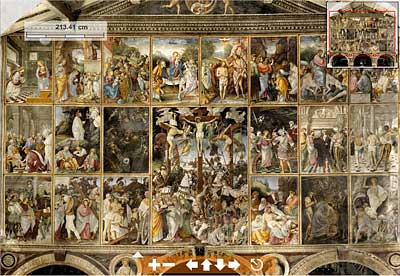
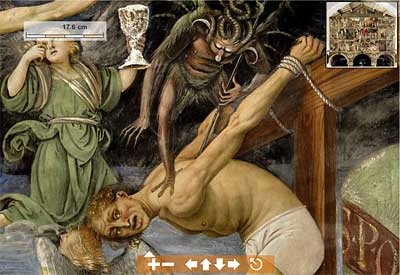

[more]
thanks to Neatorama
egypt
Chris Hedges—Inside Egypt
Editor’s note: In this article, the former New York Times Middle East bureau chief spends 10 days living with a lower-middle-class Egyptian family to expose the side of Egypt off-limits to most tourists—one made desperate by poverty and kept fearful by the omnipresent threat of state security officials.
|
A line of 80 buses and vans idles as black-uniformed police move with clipboards and snub-nosed machineguns from driver to driver collecting information. Tourists, their faces beet-colored, peer from the aquarium-like windows of the buses above onto the teeming world of the street. The high-pitched whine of motorcycles, the honking and squeal of car horns and the rumble of decrepit blue and white taxis unite in a strident chorus. Bicyclists in long, flowing gray and white galabayas and turbans weave deftly in and out of the traffic. On the banks of the river, flat-roofed tour boats and floating hotels with names like Cheops III or Hamees are berthed three to a pier. Couples in bathing suits sit on the roofs, next to the pools, shaded by the awning stretched over the boats.
The buses, given a signal at the front of the line, begin to move forward. The convoy rumbles toward the resorts on the Red Sea, escorted by police in pickup trucks. The mud-walled villages, the irrigation ditches, the dirt yards with chickens and donkeys and cattle, the barefoot children, the fields of sugar cane, the whitewashed domed tombs of local sheiks, the spindly blue and white minarets, the donkey carts with old car tires, the overcrowded passenger buses belching diesel smoke and tilting under the weight of the human cargo and the dilapidated cars and tractors held up at intersections so the convoy can pass rapidly become a blur, an indistinct and faintly remembered reminder of another Egypt.
There are two Egypts. One is crushed by poverty and groaning under the weight of an autocratic regime that has been in place for nearly three decades. This Egypt is increasingly desperate, as the country’s population growth soars, and its economy, burdened by corruption and a stifling state bureaucracy, stagnates. Out of the bowels of this Egypt have come mounting anti-government street demonstrations, anger, frustration and renewed acts of terrorist violence by Islamic militants. The second Egypt, the one on view to foreign visitors, bears little in common with the first Egypt. It is a manicured and heavily guarded Egypt of air-conditioned hotels, Nile cruises, majestic archeological sites, afternoons by swimming pools, evenings in disco clubs, posh restaurants and shops crammed with copies of statues of Horus and Nefertiti and glass jewelry cases filled with silver and gold hieroglyphic pendants.
But the clash between these two Egypts is mounting. It has left tourists, confined to these islands of privilege, caught in the middle, seen as symbols of all that is denied to most Egyptians. And once again, as they were a decade ago, foreigners are being targeted and killed by armed militants as the government of President Hosni Mubarak promises reforms, including presidential and parliamentary election reform that Mubarak’s critics dismiss as cosmetic.
| |
[more]
book recommendation
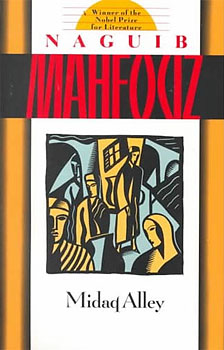
Midaq Alley
by Naguib Mahfouz
Naguib Mahfouz died recently. He is an Egyptian writer who won the Nobel Prize for literature. His masterpiece is The Cairo Trilogy: Palace Walk, Palace of Desire, Sugar Street. I read Palace Walk years ago and then, some time later, bought Palace of Desire but, by that time, I had forgotten too much of Palace Walk. I need to go back and read the whole thing at once. Until then there is this absolute gem. From Amazon:
|
Written in the 1940s, this novel by the Egyptian Nobel laureate Mahfouz deals with the plight of impoverished classes in an old quarter of Cairo. The lives and situations depicted create an atmosphere of sadness and tragic realism. Indeed, few of the characters are happy or successful. Protagonist Hamida, an orphan raised by a foster mother, is drawn into prostitution. Kirsha, the owner of a cafe in the alley, is a drug addict and a lustful homosexual. Zaita makes a living by disfiguring people so that they can become successful beggars. Transcending time and place, the social issues treated here are relevant to many Arab countries today. With this satisfying tale, Mahfouz, often called the Charles Dickens of Arabic literature, achieves a high level of excellence as a novelist and storyteller.
| |
[more]
Naquib Mahfouz, 9/11 and the Cruelty of Memory
Egypt's Greatest Writer
By Edward Said
|
Before he won the Nobel Prize in 1988, Naguib Mahfouz was known outside the Arab world to students of Arab or Middle Eastern studies largely as the author of picturesque stories about lower-middle-class Cairo life. In 1980 I tried to interest a New York publisher, who was then looking for "Third World" books to publish, in putting out several of the great writer's works in first-rate translations, but after a little reflection the idea was turned down. When I inquired why, I was told (with no detectable irony) that Arabic was a controversial language.
A few years later I had an amiable and, from my point of view, encouraging correspondence about him with Jacqueline Onassis, who was trying to decide whether to take him on; she then became one of the people responsible for bringing Mahfouz to Doubleday, which is where he now resides, albeit still in rather spotty versions that dribble out without much fanfare or notice. Rights to his English translations are held by the American University in Cairo Press, so poor Mahfouz, who seems to have sold them off without expecting that he would someday be a world- famous author, has no say in what has obviously been an unliterary, largely commercial enterprise without much artistic or linguistic coherence.
To Arab readers Mahfouz does in fact have a distinctive voice, which displays a remarkable mastery of language yet does not call attention to itself. I shall try to suggest in what follows that he has a decidedly catholic and, in a way, overbearing view of his country, and, like an emperor surveying his realm, he feels capable of summing up, judging, and shaping its long history and complex position as one of the world's oldest, most fascinating and coveted prizes for conquerors like Alexander, Caesar, and Napoleon, as well as its own natives.
to convey them in a manner entirely his own--powerful, direct, subtle. Like his characters (who are always described right away, as soon as they appear), Mahfouz comes straight at you, immerses you in a thick narrative flow, then lets you swim in it, all the while directing the currents, eddies, and waves of his characters' lives, Egypt's history under prime ministers like Saad Zaghlul and Mustafa El-Nahhas, and dozens of other details of political parties, family histories, and the like, with extraordinary skill. Realism, yes, but something else as well: a vision that aspires to a sort of all-encompassing view not unlike Dante's in its twinning of earthly actuality with the eternal, but without the Christianity.
| |
[more]
iran
Politics, Iranian Style
|
Before Father and I left for Iran I told myself I would not post about politics. I'm still very hesitant to do so, mostly because people will think I have 'gone native' if I do. But sometimes it's just more important to report what I see, no matter how far away it is from the Western media portrayal of Iran. In Iran's case the reality of life could not be any farther away from the American perception of the Islamic Republic of Iran.
[...]
But there is progress: several weeks ago about 100 women went to a soccer match, actually forced their way into it, and sat where they pleased. No one stopped them.
And who did they find their inspiration from? In their quest for equal treatment in the eyes of their fellow citizens, Iranian women invoked the name of the patron saint of the American civil rights movement: Rosa Parks. In their struggle to put an end to the constant stream of slights and indignities thrust upon them by the clerical establishment they looked to us, to America. They looked to our soft power, our ideas, our values, or as Lincoln would say, "our better angels."
But that's just the negative side of the ledger, so let's take a look at the positive. Women can drive. Women can vote. Women can work. Women can smoke. They have free and unfettered access (at least in the big cities) to contraception and this is legal and tolerated by the theocratic establishment! Women hold 30 seats in the Iranian parliament, more than the full total in America. And the huge population bulge of 30 something's and younger is forcing changes on the country as I type.
Did you know that men and women are living with each for years at a time without getting married? To many people in America this is still scandalous behavior. (Personally I think it unwise, but I believe in people making their own choices.) Did you know that when people are inside the home what is done there is considered inviolable? The Iranians have parties, they dance, they drink and they smoke, all without the onerous hejab restrictions.
| |
[more]
cameras
Leica's new digital M8 is a Grand Slam. My rangefinder cameras cost me from $19 to $27 so the M8, at $4,500, is a bit out of my league. But a fellow can dream, can't he?

Leica M8
A Hands-on Field Review
|
After re-reading this report one final time before publishing it I am almost embarrassed by how "gushing" it appears to be. I don' t think that in all my years of writing camera reviews I've ever been as generous in my comments about a new camera as I have been here with regard to the Leica M8. But, try as I might I find little to fault in any regard. The conversion of the M series from film-based to digital has been accomplished about as well as one could wish, and almost all of the hallmark Leica qualities, refined over more than a half century of making essentially the same model, have been retained.
The bottom line is this. If you know and appreciate what an M Leica is about, you'll find that the M8 fulfills its promise. If you can afford one, then run don't walk to your local dealer. If the M8 and rangefinder cameras in general aren't your cup of tea, that's fine. It just means that M8's will be easier to find by those that do want them, the less people that are waiting in line.
Now, if you'll excuse me, I have to go argue with Leica USA about returning their test sample. As the saying goes – only from my cold dead hands.
| |
[more]
water
The Bottled Water Lie
The corporations that sell bottled water are depleting natural resources, jacking up prices, and lying when they tell you their water is purer and tastes better than the stuff that comes out of the tap.
|
When Antonia Mahoney moved to Boston from her native Puerto Rico 35 years ago, the first thing she noticed was how much better the water tasted. Over the years, however, the water she was receiving from her tap began to lose its appeal. "Little by little, the taste changed," says the retired schoolteacher, who eventually gave up tap water altogether and began paying over $30 a month to get bottles of Poland Spring water delivered to her house.
Walking through Boston's Copley Square on a sunny day last month, however, she was intrigued by a banner advertising something called the "Tap Water Challenge." As she approached the table, a fresh-faced activist behind it told her the "challenge" was a blind taste test to see if passersby could tell the difference between bottled water and tap water. Mahoney turned her back while four water samples were poured into small paper cups -- two of tap water from Boston and a nearby suburb, and one each of Poland Spring and Aquafina.
"That's tap water," Mahoney declared after draining the first cup. "That tastes just like what I drink at home." Her confidence faded, however, as she downed the next three, which all seemed to taste the same. When the cups were turned over, it turned out that what she thought was tap water was actually Aquafina -- and what she thought was Poland Spring was actually the same Boston tap water she gets at home for free. "I couldn't believe it, I couldn't believe it," she says later. "You know I pay so much for that water. Now I am thinking to stop the Poland Spring."
| |
[more]
blogroll
I've added some new blogs to the blogroll. 6 new photographer blogs. Some are very professional while the others are passionate. Check them out to see which is which. Also a new blog in a new category: sustainablity.
photographer blogs
Daily Walks
dispatches
Joe Reifer - Words
Musings on Photography
Not If But When #2
xtoid
sustainablity
WorldChanging
global climate change
Tomgram: Bill McKibben on Our Planetary Fate
|
Putting aside questions of planetary consciousness and will (beloved as they were by an early wave of New Age Gaia acolytes), the theory may help us understand how the earth has managed to remain hospitable for life over billions of years even as the sun, because of its own stellar evolution, has become significantly hotter. Through a series of processes involving, among others, ice ages, ocean algae, and weathering rock, the earth has managed to keep the amount of heat-trapping carbon dioxide in the atmosphere, and hence the temperature, at a relatively stable level.
This homeostasis is now being disrupted by our brief binge of fossil fuel consumption, which has released a huge amount of carbon dioxide into the atmosphere. Indeed, at one point Lovelock predicts -- more gloomily than any other competent observer I am aware of -- that we have already pushed the planet over the brink, and that we will soon see remarkably rapid rises in temperature, well beyond those envisioned in most of the computer models now in use – themselves quite dire. He argues that because the earth is already struggling to keep itself cool, our extra increment of heat is particularly dangerous, and he predicts that we will soon see the confluence of several phenomena: the death of ocean algae in ever-warmer ocean waters, reducing the rate at which these small plants can remove carbon from the atmosphere; the death of tropical forests as a result of higher temperatures and the higher rates of evaporation they cause; sharp changes in the earth's "albedo," or reflectivity, as white ice that reflects sunlight back out into space is replaced with the absorptive blue of seawater or the dark green of high-latitude boreal forests; and the release of large amounts of methane, itself a greenhouse gas, held in ice crystals in the frozen north or beneath the sea.
Some or all of these processes will be enough, Lovelock estimates, to tip the earth into a catastrophically hotter state, perhaps eight degrees centigrade warmer in temperate regions like ours, over the course of a very few decades, and that heat will in turn make life as we know it nearly impossible in many places. Indeed, in the photo section of the book there is one picture of a red desert captioned simply "Mars now -- and what the earth will look like eventually." Human beings, a hardy species, will not perish entirely, he says; in interviews during his book tour, Lovelock has predicted that about 200 million people, or about one thirtieth of the current world population, will survive if competent leaders make a new home for us near the present-day Arctic. There may also be other survivable spots, like the British Isles, though he notes that rising sea levels will render them more an archipelago. In any event, he predicts that "teeming billions" will perish.
| |
[more]
White House Nods (Imperceptibly) at Stern Report
|
The devastating Stern Review on the Economics of Climate Change, released in Britain on Monday, should have gotten hour-long segments on television news and three-inch headlines in the U.S. No surprise that it didn't. If you took the time to drill down in what coverage there was here, you could see exactly what the Bush Regime is not doing.
| |
[more]
Budgets Falling in Race to Fight Global Warming
|
The challenge is all the more daunting because research into energy technologies by both government and industry has not been rising, but rather falling.
In the United States, annual federal spending for all energy research and development — not just the research aimed at climate-friendly technologies — is less than half what it was a quarter-century ago. It has sunk to $3 billion a year in the current budget from an inflation-adjusted peak of $7.7 billion in 1979, according to several different studies.
| |
[more]
thanks to daily KOS
Stern Review: How Climate Change is Revolutionizing Economics
"The benefits of strong, early action on climate change outweigh the costs."
|
The sentence appears as a paragraph by itself, in bold, in the Executive Summary of the now-released, much-anticipated Stern Review on the Economics of Climate Change.
The numbers underscore the point: addressing the problem now will cost about 1% of GDP per year. Doing nothing, say the economic models, will cost the world the loss of 5% GDP per year -- "now and forever" says the report, evoking an almost religious tone. That 5% figure is actually the best case scenario for doing nothing: if all the risk factors are taken into account, and they all hit home (an appropriate phrase in this case, since our homes are what they will hit), then the figure could be as high as 20%.
This conclusion, and these figures, are what will be most remembered about this report -- that, and the media/policy splash it's making. We'll get into the details (there are 700 pages of them, so we certainly won't get into too many) later in this article. Let's first consider the frame and context.
| |
[more]
Stern Review final report
|
The pre-publication edition of the Stern Review Report on the Economics of Climate Change is available to be downloaded below either on a chapter-by-chapter basis or in parts covering broader themes. The report is available in Adobe Acrobat Portable Document Format (PDF).
| |
[more]
scanner
* We love you -- happy birthday; the sequel !!! * xo+ ..love the gillman gals
Epson Perfection V700 Photo Color Scanner
That was an email I got a couple of days ago. Quite a while ago Zoe and Gerry agreed to give me a special birthday. Part of it was in appreciation for the help I've given Gerry. The first part was a new computer. That is up and running. The scanner is the second part.

It's the Epson V700. It was more than I originally had planned on but I have some paying scanning work coming up so I went for the best flatbed. This eats a little into the third part of the birthday present, a HP B9180 13" wide pigment printer that will be coming in another month or two. I will have to add a few dollars for that one but it will all be worth it.
It's been a long time. Almost 30 years. I had my own darkroom in the 1970s. Part of the reason I got out of photography, in addition to getting married and having three children, was the frustration in not being able to afford the equipment to print like I wanted to. And that was black and white. I was getting into color and, although I had printed color working in a photo lab, printing color at home was very expensive. By the end of the 1970s I had stopped printing. Over the next few years I looked into Carbon printing, Platinum printing, and even Dye Transfer for color. But reality kept any of it from happening. I even tried having labs print Cibachrome but I hated the colors. In 1995 I bought my first PC (I had an Apple IIc in 1985) with an early Epson photo printer, an Olympus digital camera, and Photoshop. My early enthusiasm was dashed when I realized the prints faded pretty fast. My next bout of hope was 4 years ago when I upgraded my computer, bought an Epson C80 pigment printer, and started scanning negatives with an Epson 2450. This combination was closer. The pigment prints lasted much longer but it was only a 4 color printer and it just didn't have the gamut I wanted, even for black and white. The Epson scanner did a good job but not really good enough for 35mm. With the V700 scanner and the HP B9180 printer I will finally be able to make the prints I wanted to 30 years ago. Actually, a lot better prints.
Learning all this new equipment and software is like drinking from a fire hose. In the software department I've added Photoshop CS2 (up from Photoshop 6), Noise Ninja, and FocalBlade for sharpening. I just picked up Martin Evening's Adobe Photoshop CS2 for Photographers and Katrin Eismann's Adobe Photoshop Restoration & Retouching. (I have some restoration work to do and I want to do more. I love restoring old photos!) I need to get serious about learning all this shit. I need to be ready for that printer! Thanks to Zoe and Gerry for making this dream happen.
The scanner left Maspeth, NY, yesterday to arrive Monday, November 6. But who's excited?
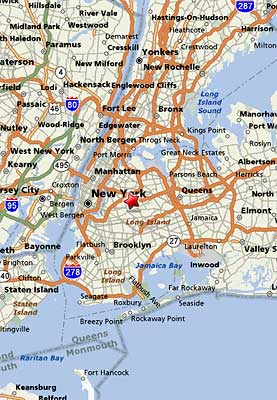
|
|
|
|









